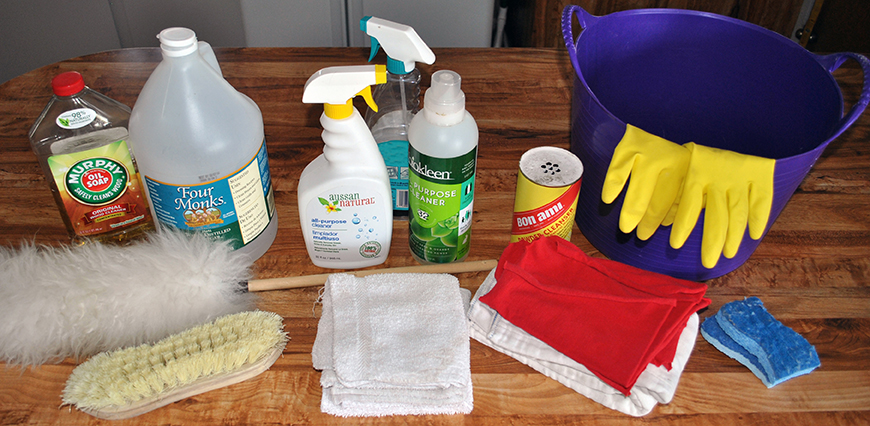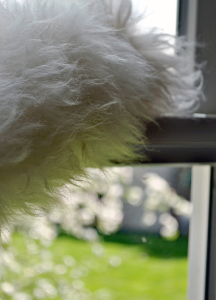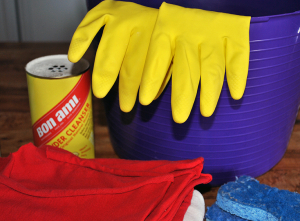Spring Cleaning — The Natural Way

Save Money—Save the Planet
 Now that I’ve purged a ton of excess stuff, it’s time to get down to deep cleaning. The weather is just right for opening windows and hanging sheets on the line.
Now that I’ve purged a ton of excess stuff, it’s time to get down to deep cleaning. The weather is just right for opening windows and hanging sheets on the line.
Growing up in the ‘60s–‘70s, I believed housecleaning meant using the products advertised on TV. The brand names were abundant. Pine-sol, Pledge, Windex, Mr. Clean, Ajax, Lysol, Spic n’ Span, Simoniz, Glo-Coat, Brillo—all promised to make our houses sparkling clean. Many of those brands are still on the shelves today, and dozens more have been added, most products of chemical companies like Monsanto and Dow.
Alongside our mothers, we dutifully used the latest and greatest with little thought to how these powerful cleaners might be affecting our own health, let alone that of the environment.
Today, many people are aware of the harm caused by the chemicals used in the “safe” cleaning products on our store shelves, but certainly not enough. Research shows the market for such products increasing, but there is hope. As more people become aware of the need to reduce our dependence on products with harmful chemicals, plant-based and natural cleaners are becoming more popular.
 For that, we go back to the methods used by my grandmother and the perfect ingredient for a variety of cleaners—white vinegar! The Internet is full of recipe sources, but vinegartips.com is my favorite: 1001 Uses for White Distilled Vinegar. Because of its high acid content, vinegar is effective at killing both mold and bacteria. You will be amazed at how well it tackles bathroom soap scum.
For that, we go back to the methods used by my grandmother and the perfect ingredient for a variety of cleaners—white vinegar! The Internet is full of recipe sources, but vinegartips.com is my favorite: 1001 Uses for White Distilled Vinegar. Because of its high acid content, vinegar is effective at killing both mold and bacteria. You will be amazed at how well it tackles bathroom soap scum.
In addition to vinegar, my natural cleaning toolbox includes Murphy’s Oil Soap for wood surfaces and Bon Ami, a great abrasive cleanser for stainless steel. I keep a few pre-made natural products for spot cleaning when I don’t have time to make my own, but they are expensive, so I use them sparingly. Biokleen’s Bac-Out line is especially useful if you have pets, as its live enzyme cultures eat away at urine stains and odor. If you want a scent, like lavender or almond, I suggest one of Dr. Bronner’s pure-castile soaps.
Instead of paper towels (which I reserve for food prep), I use rags (old washcloths/towels and diapers, and cut-up old T-shirts), retired dish sponges, and a fabulous, long-handled, fluffy duster made from lambswool. The T-shirts work especially well on a Swifter—instead of the who-knows-what-it’s-made-from fiber cloths that cost a fortune. Cut them with enough excess to fit, dampen and attach—great for cleaning wood floors under beds. The duster is perfect for anything high, especially cobwebs and the tops of molding. It does a good job dusting mini-blinds too.
 I carry it all around the house in a spiffy rubber tub with handles (available in garden-supply stores). Of course, I always use latex gloves to protect my skin and keep my hands dry while working. Armed also with a broom and dust-pan, and a vacuum cleaner for rugs, I’m ready to get down to business.
I carry it all around the house in a spiffy rubber tub with handles (available in garden-supply stores). Of course, I always use latex gloves to protect my skin and keep my hands dry while working. Armed also with a broom and dust-pan, and a vacuum cleaner for rugs, I’m ready to get down to business.
Using natural products might mean you have to add a bit of extra elbow grease, but the results are worth it. Your house will smell clean and fresh without the underlying chemical scent of many products. And, you can feel good knowing that you’re not adding a ton of chemicals into the wastewater that eventually ends up in our water system. The creatures of the oceans thank you!
- Words by Andrea Leigh Ptak
- April 15, 2014
- 2 Comments
Great post and a good reminder…Vinegar does a great job on glass.
Love the idea of using cloth for your swifter. I am with you on using safe products. Have a similar stock here.